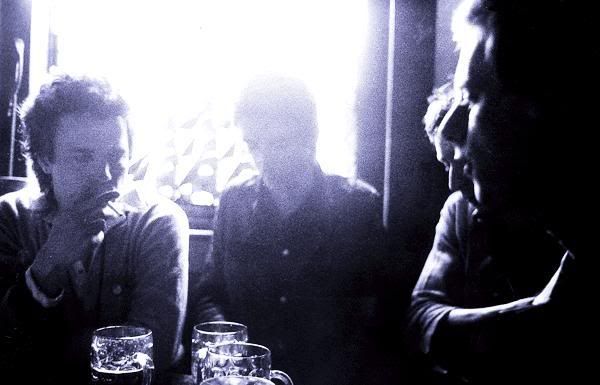
Political Systems 101 Final Exam
QUESTION: If the English band Wire was a government, they could be defined as:
A. A military junta
B. A philosophical dictatorship
C. Anarchy
D. None of the above
If I were the one gripping the #2 pencil, I’d be stuck between choices B and D. Philosophical dictatorships are rare and incredibly difficult to explain. I can only think of one off-hand, and that’s the rule of Dr. Francia in Paraguay at the end of the 19th century.Hmmmmm, but “None of the Above” is always an acceptable cop-out.
Either way, I’d be sweating bullets by this point in the exam.
Post-punk can be such a poor definition of music. But in the last four years, it’s come to mean anything that resembles the first two releases by Gang of Four. You know, anything that reviewers describe as having an “angular guitar sound.” Huh? Why not something a bit more descriptive such as “abrasive” or “lacking mid-range”?
A more appropriate definition of post-punk would read as such
“Anything recorded after the Sex Pistols’ tabloid frenzy stopped being such a vile influence on the music.”
The arrival of art students and decidedly unhip non-Londoners allowed punk to exchange controversy for artistic freedom. Reggae and dub, classical, ambient, even field recordings of African drummers found their way into the post-punk cannon. The result was, gasp, people being experimental and at times, self-indulgent. Holy Sid Vicious!!!
Wire -a band that’s had more than it’s share of difficult musical moments- get such little love from post-punk revivalists. Oh sure, critics adore them and Elastica made them cool for a while in the mid 1990s, but they have consistently been overshadowed by their more accessible peers.
In short, Wire were a very self-indulgent group. But not in that annoying Emerson, Lake and Palmer sort of way. Nowhere was this more evident than when the band was on the road. Set lists from tours following 1978’s “Chairs Missing” were heavy on unreleased material and as a result, the majority of “154” had been road tested and rehearsed long before entering the studio. While this may have been vexing for fans, I’m doubtful that the lads ever cared. For them, live performances were an ideal testing ground for what was to be their increasingly adventurous ideas.
“154” is Wire at their most stubborn. Accompanied by producer/pianist/arranger Mike Thorne, the boys deliver forty minutes of buzzing guitars, beautiful harmonies, droning keyboards and the occasional spoken word piece. It’s Dada on record, and like Dada they occasionally wrap the absurd in the in a digestible package. Take “Map Ref. 41ºN 93ºW,” for example. It features beautiful chord changes and a superb melody, yet it’s about lines of latitude and longitude. Can you picture yourself singing along to lyrics that sound like they were lifted from a surveyor’s manual? Probably not. But this was not unusual behavior from Wire. A single from the previous album, “Outdoor Miner”, addressed the habits of the leaf-dwelling serpentine miner. And when they resurfaced in the mid-80s, Wire continued to wreak havoc on convention by writing pop numbers with increasingly abstract lyrics.
“Tim Souster was an old composer friend who had studied and played under Karlheinz Stockhausen, was utterly at home with electronic sound•• and played the electric viola (or had done, since he had to get it fixed for this session). We set him up with his viola feeding three separate amps each with a time delay in its path (we had three Music Man combo models among us). The enveloping sound in his playing area in the middle of the large studio was magic.”
It is evident that there was a method to the group’s madness. Wire sought to emulate the masters of the avant-garde and they were meticulous in their noisemaking expeditions. However, some of the experimental tracks on “154” can be frustrating because they change direction before one can understand what took place. “The Other Window”, which begins as an inoffensive ambient piece, takes on a sinister tone when an off-kilter drumbeat is introduced around the one-minute mark. “A Touching Display,” creeps along for seven minutes and abruptly ends with a fartlike bum note. Depending on your tastes these moments can be agonizing or exhilarating.
“154” is not a party album. In fact, I’m so sure of this that I’ll pay you $5 if you can provide evidence of this album being played in a club or bar. Nonetheless, if you listen to “Pink Flag” and then “Chairs Missing” in succession, you’ll be adequately prepared to listen to “154” in its entirety at least once. If not, you can always cheat and just play “The 15th” on repeat for a week.
(Special Thanks to Dan M. for advice on this one. And apologies for the delay, but it’s Christmas, you know.)

MORE INFORMATION
The Making of “154” by Mike Thorne
Performance of “The 15th” on West German TV



3 comments:
hey! it's not cheating if that's the only song you have! i really like the video that you included. stellar as always.
I went to 41ºN 93ºW on Google Earth. Sadly, there was nothing there.
Great entry - you are a good writer who captures the audience. Check out the first part of Stockhausen's "Kreuzspiel". If you can't get a recording from a library or a friend i'll send one over. It's completely serialized music, yet beautiful, tribal, and seems so coherent, planned, musical, and well put together. Let me know what you think.
Post a Comment